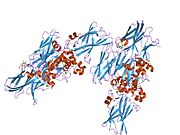TGM3
| TGM3 | |||
|---|---|---|---|
Gene ontology | |||
| Molecular function | |||
| Cellular component | |||
| Biological process | |||
| Sources:Amigo / QuickGO | |||
Ensembl | |||||||||
|---|---|---|---|---|---|---|---|---|---|
| UniProt | |||||||||
| RefSeq (mRNA) | |||||||||
| RefSeq (protein) | |||||||||
| Location (UCSC) | Chr 20: 2.3 – 2.34 Mb | Chr 2: 129.85 – 129.89 Mb | |||||||
| PubMed search | [3] | [4] | |||||||
| View/Edit Human | View/Edit Mouse |
Protein-glutamine gamma-glutamyltransferase E is an enzyme that in humans is encoded by the TGM3 gene.[5][6][7]
Transglutaminases are enzymes that catalyze the crosslinking of proteins by epsilon-gamma glutamyl lysine isopeptide bonds. While the primary structure of transglutaminases is not conserved, they all have the same amino acid sequence at their active sites and their activity is calcium-dependent. The protein encoded by this gene consists of two polypeptide chains activated from a single precursor protein by proteolysis. The encoded protein is involved the later stages of cell envelope formation in the epidermis and hair follicle.[7]
See also
- Proximal promoter
References
- ^ a b c GRCh38: Ensembl release 89: ENSG00000125780 – Ensembl, May 2017
- ^ a b c GRCm38: Ensembl release 89: ENSMUSG00000027401 – Ensembl, May 2017
- ^ "Human PubMed Reference:". National Center for Biotechnology Information, U.S. National Library of Medicine.
- ^ "Mouse PubMed Reference:". National Center for Biotechnology Information, U.S. National Library of Medicine.
- PMID 7851911.
- PMID 9452468.
- ^ a b "Entrez Gene: TGM3 transglutaminase 3 (E polypeptide, protein-glutamine-gamma-glutamyltransferase)".
Further reading
- Ahvazi B, Boeshans KM, Rastinejad F (2005). "The emerging structural understanding of transglutaminase 3". J. Struct. Biol. 147 (2): 200–7. PMID 15193648.
- Rice RH, Green H (1978). "Relation of protein synthesis and transglutaminase activity to formation of the cross-linked envelope during terminal differentiation of the cultured human epidermal keratinocyte". J. Cell Biol. 76 (3): 705–11. PMID 24643.
- Steck TL (1972). "Cross-linking the major proteins of the isolated erythrocyte membrane". J. Mol. Biol. 66 (2): 295–305. PMID 5038456.
- Mariniello L, Esposito C, Di Pierro P, et al. (1993). "Human-immunodeficiency-virus transmembrane glycoprotein gp41 is an amino acceptor and donor substrate for transglutaminase in vitro". Eur. J. Biochem. 215 (1): 99–104. PMID 7688299.
- Amendola A, Lombardi G, Oliverio S, et al. (1994). "HIV-1 gp120-dependent induction of apoptosis in antigen-specific human T cell clones is characterized by 'tissue' transglutaminase expression and prevented by cyclosporin A". FEBS Lett. 339 (3): 258–64. S2CID 39872629.
- Kim IG, Lee SC, Lee JH, et al. (1994). "Structure and organization of the human transglutaminase 3 gene: evolutionary relationship to the transglutaminase family". J. Invest. Dermatol. 103 (2): 137–42. PMID 7913719.
- Kim IG, Gorman JJ, Park SC, et al. (1993). "The deduced sequence of the novel protransglutaminase E (TGase3) of human and mouse". J. Biol. Chem. 268 (17): 12682–90. PMID 8099584.
- Lee JH, Jang SI, Yang JM, et al. (1996). "The proximal promoter of the human transglutaminase 3 gene. Stratified squamous epithelial-specific expression in cultured cells is mediated by binding of Sp1 and ets transcription factors to a proximal promoter element". J. Biol. Chem. 271 (8): 4561–8. PMID 8626812.
- Hillier LD, Lennon G, Becker M, et al. (1997). "Generation and analysis of 280,000 human expressed sequence tags". Genome Res. 6 (9): 807–28. PMID 8889549.
- Kim SY, Grant P, Lee JH, et al. (1999). "Differential expression of multiple transglutaminases in human brain. Increased expression and cross-linking by transglutaminases 1 and 2 in Alzheimer's disease". J. Biol. Chem. 274 (43): 30715–21. PMID 10521460.
- Méhul B, Bernard D, Simonetti L, et al. (2000). "Identification and cloning of a new calmodulin-like protein from human epidermis". J. Biol. Chem. 275 (17): 12841–7. PMID 10777582.
- Deloukas P, Matthews LH, Ashurst J, et al. (2002). "The DNA sequence and comparative analysis of human chromosome 20". Nature. 414 (6866): 865–71. PMID 11780052.
- Sárdy M, Kárpáti S, Merkl B, et al. (2002). "Epidermal transglutaminase (TGase 3) is the autoantigen of dermatitis herpetiformis". J. Exp. Med. 195 (6): 747–57. PMID 11901200.
- Strausberg RL, Feingold EA, Grouse LH, et al. (2003). "Generation and initial analysis of more than 15,000 full-length human and mouse cDNA sequences". Proc. Natl. Acad. Sci. U.S.A. 99 (26): 16899–903. PMID 12477932.
- Ahvazi B, Boeshans KM, Idler W, et al. (2003). "Roles of calcium ions in the activation and activity of the transglutaminase 3 enzyme". J. Biol. Chem. 278 (26): 23834–41. PMID 12679341.
- Hitomi K, Presland RB, Nakayama T, et al. (2004). "Analysis of epidermal-type transglutaminase (transglutaminase 3) in human stratified epithelia and cultured keratinocytes using monoclonal antibodies". J. Dermatol. Sci. 32 (2): 95–103. PMID 12850301.
- Gonzalez HE, Gujrati M, Frederick M, et al. (2003). "Identification of 9 genes differentially expressed in head and neck squamous cell carcinoma". Arch. Otolaryngol. Head Neck Surg. 129 (7): 754–9. PMID 12874078.
- Ahvazi B, Boeshans KM, Idler W, et al. (2004). "Structural basis for the coordinated regulation of transglutaminase 3 by guanine nucleotides and calcium/magnesium". J. Biol. Chem. 279 (8): 7180–92. PMID 14645372.








